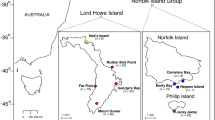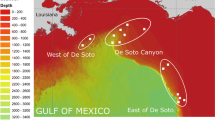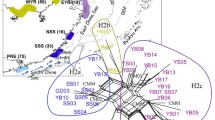Abstract
How and when dingoes arrived in Oceania poses a fascinating question for scientists with interest in the historical movements of humans and dogs. The dingo holds a unique position as top terrestrial predator of Australia and exists in a wild state. In the first geographical survey of genetic diversity in the dingo using whole mitochondrial genomes, we analysed 16,428 bp in 25 individuals from five separate populations. We also investigated 13 nuclear loci to compare with the mitochondrial population history patterns. Phylogenetic analyses based upon mitochondrial DNA and nuclear DNA support the hypothesis that there are at least two distinct populations of dingo, one of which occurs in the northwest and the other in the southeast of the continent. Conservative molecular dating based upon mitochondrial DNA suggest that the lineages split approximately 8300 years before present, likely outside Australia but within Oceania. The close relationship between dingoes and New Guinea Singing Dogs suggests that plausibly dingoes spread into Australia via the land bridge between Papua New Guinea and Australia although seafaring introductions cannot be rejected. The geographical distribution of these divergent lineages suggests there were multiple independent dingo immigrations. Importantly, the observation of multiple dingo populations suggests the need for revision of existing conservation and management programs that treat dingoes as a single homogeneous population.



Similar content being viewed by others
References
Anderson TM et al (2009) Molecular and evolutionary history of melanism in North American gray wolves. Science 323:1339–1343. doi:10.1126/science.1165448
Ardalan A, Oskarsson M, Natanaelsson C, Wilton A, Ahmadian A, Savolainen P (2012) Narrow genetic basis for the Australian dingo confirmed through analysis of paternal ancestry. Genetica 140:65–73. doi:10.1007/s10709-012-9658-5
Arendt M, Cairns KM, Ballard JWO, Savolainen P, Axelsson E (2016) Diet adaptation in dog reflects spread of prehistoric agriculture. Heredity. doi:10.1038/hdy.2016.48
Bocquet-Appel J-P (2011) When the world’s population took off: the springboard of the neolithic demographic transition. Science 333:560–561. doi:10.1126/science.1208880
Brown RP, Yang Z (2011) Rate variation and estimation of divergence times using strict and relaxed clocks. BMC Evol Biol 11:271
Cairns KM (2015) Population differentiation in the dingo: biogeography and molecular ecology of the Australian Native Dog using maternal, paternal and autosomal genetic markers. University of New South Wales, Sydney
Carmichael LE, Nagy JA, Larter NC, Strobeck C (2001) Prey specialization may influence patterns of gene flow in wolves of the Canadian Northwest. Mol Ecol 10:2787–2798. doi:10.1046/j.0962-1083.2001.01408.x
Carthey AJR, Banks PB (2012) When does an alien become a native species? A vulnerable native mammal recognizes and responds to its long-term alien predator. PLoS ONE 7:e31804. doi:10.1371/journal.pone.0031804
Corbett LK (1995) The dingo in Australia and Asia. University of NSW Press, Sydney
Darriba D, Taboada GL, Doallo R, Posada D (2012) jModelTest 2: more models, new heuristics and parallel computing. Nat Methods 9:772–772. http://www.nature.com/nmeth/journal/v9/n8/abs/nmeth.2109.html—supplementary-information
David B et al (2013) A 28,000 year old excavated painted rock from Nawarla Gabarnmang, northern Australia. J Archaeol Sci 40:2493–2501. doi:10.1016/j.jas.2012.08.015
Davis E (2001) Legislative issues relating to control of dingoes and other wild dogs in New South Wales. 1. Approaches to future management. In: Dickman CR, Lunney D (eds) A symposium on the Dingo. Royal Zoological Society of New South Wales, Sydney
Diamond J (2002) Evolution, consequences and future of plant and animal domestication. Nature 418:700–707
Drummond AJ, Suchard MA, Xie D, Rambaut A (2012) Bayesian phylogenetics with BEAUti and the BEAST 1.7. Mol Biol. doi:10.1093/molbev/mss075
Evanno G, Regnaut S, Goudet J (2005) Detecting the number of clusters of individuals using the software structure: a simulation study. Mol Ecol 14:2611–2620. doi:10.1111/j.1365-294X.2005.02553.x
Excoffier L, Lischer HEL (2010) Arlequin suite ver 3.5: a new series of programs to perform population genetics analyses under Linux and Windows Mol. Ecol Res 10:564–567. doi:10.1111/j.1755-0998.2010.02847.x
Fillios MA, Taçon PSC (2016) Who let the dogs in? A review of the recent genetic evidence for the introduction of the dingo to Australia and implications for the movement of people. J Archaeol Sci Rep. doi:10.1016/j.jasrep.2016.03.001
Fleming P, Corbett LK, Harden R, Thomson P (2001) Managing the impacts of dingoes and other wild dogs. Bureau of Rural Sciences, Canberra
Frantz LAF et al (2016) Genomic and archaeological evidence suggest a dual origin of domestic dogs. Science 352:1228–1231. doi:10.1126/science.aaf3161
Freedman AH et al (2014) Genome sequencing highlights the dynamic early history of dogs. PLoS Genet 10:e1004016. doi:10.1371/journal.pgen.1004016
Fu YX (1997) Statistical tests of neutrality of mutations against population growth. Hitchhiking Backgr Sel Genet 147:915–925
Gibbons A (2001) The peopling of the Pacific. Science 291:1735–1737. doi:10.1126/science.291.5509.1735
Gollan K (1984) The Australian dingo: in the shadow of man. In: Archer M, Clayton G (eds) Vertebrate zoogeography and evolution in Australasia. Hesperian Press, Carlisle
Haak W et al (2010) Ancient DNA from european early neolithic farmers reveals their near eastern affinities. PLoS Biol 8:e1000536. doi:10.1371/journal.pbio.1000536
Ho SYW, Lanfear R, Bromham L, Phillips MJ, Soubrier J, Rodrigo AG, Cooper A (2011) Time-dependent rates of molecular evolution. Mol Ecol 20:3087–3101. doi:10.1111/j.1365-294X.2011.05178.x
Ho SYW, Larson G (2006) Molecular clocks: when times are a-changin’. Trends Genet 22:79–83
van Holst Pellekaan S (2013) Genetic evidence for the colonization of Australia. Quat Int 285:44–56. doi:10.1016/j.quaint.2011.04.014
Hubisz MJ, Falush D, Stephens M, Pritchard JK (2009) Inferring weak population structure with the assistance of sample group information. Mol Ecol Res 9:1322–1332. doi:10.1111/j.1755-0998.2009.02591.x
Jakobsson M, Rosenberg NA (2007) CLUMPP: a cluster matching and permutation program for dealing with label switching and multimodality in analysis of population structure. Bioinformatics 23:1801–1806
Karafet TM et al (2005) Balinese Y-chromosome perspective on the peopling of Indonesia: genetic contributions from pre-neolithic hunter–gatherers, Austronesian farmers, and Indian traders. Hum Biol 77:93–114
Kennedy LJ, Angles JM, Barnes A, Carmichael LE, Radford AD, Ollier WER, Happ GM (2007) DLA-DRB1, DQA1, and DQB1 alleles and haplotypes in North American gray wolves. J Hered 98:491–499. doi:10.1093/jhered/esm051
Kidwell SM, Flessa KW (1996) The quality of the fossil record: populations, species, and communities. Annu Rev Earth Planet Sci 24:433–464. doi:10.1146/annurev.earth.24.1.433
Kingman JFC (1982) The coalescent. Stoch Proc Appl 13:235–248. doi:10.1016/0304-4149(82)90011-4
Koler-Matznick J, Brisbin IL, Feinstein M, Bulmer S (2004) An updated description of the New Guinea singing dog (Canis hallstromi, Troughton 1957). J Zool 261:109–118. doi:10.1017/S0952836903004060
Larson G et al (2007) Phylogeny and ancient DNA of Sus provides insights into neolithic expansion in Island Southeast Asia and Oceania. PNAS 104:4834–4839. doi:10.1073/pnas.0607753104
Larson G et al (2010) Patterns of East Asian pig domestication, migration, and turnover revealed by modern and ancient DNA. PNAS 107:7686–7691. doi:10.1073/pnas.0912264107
Letnic M, Greenville A, Denny E, Dickman CR, Tischler M, Gordon C, Koch F (2010) Does a top predator suppress the abundance of an invasive mesopredator at a continental scale? Global Ecol Biogeogr 20:343–353
Letnic M, Ritchie EG, Dickman CR (2012) Top predators as biodiversity regulators: the dingo Canis lupus dingo as a case study. Biol Rev 87:390–413. doi:10.1111/j.1469-185X.2011.00203.x
Librado P, Rozas J (2009) DNAsp v5: a software for comprehensive analysis of DNA polymorphism data. Bioinformatics 25:1451–1452
Macintosh NWG (1975) The origin of the dingo: an enigma. In: Fox MW (ed) The Wild Canids—their systematics, behavioural ecology and evolution. Behavioral Science. Van Nostrand Reinhold Company, New York, pp 87–106
McEvoy BP, Lind JM, Wang ET, Moyzis RK, Visscher PM, van Holst Pellekaan SM, Wilton AN (2010) Whole-genome genetic diversity in a sample of Australians with deep aboriginal ancestry. Am J Hum Genet 87:297–305. doi:10.1016/j.ajhg.2010.07.008
Milham P, Thompson P (1976) Relative antiquity of human occupation and extinct fauna at madura cave. Southeastern Western Australia Mankind 10:175–180. doi:10.1111/j.1835-9310.1976.tb01149.x
Moseby KE, Neilly H, Read JL, Crisp HA (2012) Interactions between a top order predator and exotic mesopredators in the Australian rangelands. Int J Ecol. doi:10.1155/2012/250352
Musiani M et al (2007) Differentiation of tundra/taiga and boreal coniferous forest wolves, coat color and association with migratory caribou. Mol Ecol 16:4149
Oskarsson MCR, Klütsch CFC, Boonyaprakob U, Wilton A, Tanabe Y, Savolainen P (2011) Mitochondrial DNA data indicate an introduction through Mainland Southeast Asia for Australian dingoes and Polynesian domestic dogs. Proc R Soc B. doi:10.1098/rspb.2011.1395
Pang J-F et al (2009) mtDNA data indicate a single origin for dogs south of Yangtze river, less than 16,300 years ago, from numerous wolves. Mol Biol Evol 26:2849–2864
Rambaut A, Drummond A (2007) Tracer v1.5 edn. http://beast.bio.ed.ac.uk/Tracer
Randall D, Pollinger J, Argaw K, Macdonald D, Wayne R (2010) Fine-scale genetic structure in Ethiopian wolves imposed by sociality, migration, and population bottlenecks. Cons Gen 11:89–101. doi:10.1007/s10592-009-0005-z
Ripple WJ et al (2014) Status and ecological effects of the world’s largest carnivores. Science 343. doi:10.1126/science.1241484
Robin S et al (2009) Genetic diversity of canine olfactory receptors. BMC Genom. doi:10.1186/1471-2164-10-21
Rosenberg NA (2004) DISTRUCT: a program for the graphical display of population structure. Mol Ecol Notes 4:137–138
Sacks BN, Brown SK, Ernest HB (2004) Population structure of California coyotes corresponds to habitat-specific breaks and illuminates species history. Mol Ecol 13:1265–1275. doi:10.1111/j.1365-294X.2004.02110.x
Sacks BN, Brown SK, Stephens D, Pedersen NC, Wu J-T, Berry O (2013) Y chromosome analysis of dingoes and Southeast Asian village dogs suggests a Neolithic continental expansion from Southeast Asia followed by multiple Austronesian dispersals. Mol Biol Evol 13:1265–1275. doi:10.1093/molbev/mst027
Savolainen P, Leitner T, Wilton AN, Matisoo-Smith E, Lundeberg J (2004) A detailed picture of the origin of the Australian dingo, obtained from the study of mitochondrial DNA. PNAS 101:12387–12390
Shannon LM et al (2015) Genetic structure in village dogs reveals a Central Asian domestication origin. PNAS 112:13639–13644. doi:10.1073/pnas.1516215112
Skoglund P, Ersmark E, Palkopoulou E, Dalén L (2015) Ancient wolf genome reveals an early divergence of domestic dog ancestors and admixture into high-latitude breeds. Curr Biol 25:1515–1519. doi:10.1016/j.cub.2015.04.019
Stenseth NC et al (2004) Snow conditions may create an invisible barrier for lynx. PNAS 101:10632–10634
Stephens D (2011) The molecular ecology of Australian wild dogs: hybridisation, gene flow and genetic structure at multiple geographic scales. PhD, University of Western Australia
Tacher S, Quignon P, Rimbault M, Dreano S, Andre C, Galibert F (2005) Olfactory receptor sequence polymorphism within and between breeds of dogs. J Hered 96:812–816. doi:10.1093/jhered/esi113
Tajima F (1989) Statistical method for testing the neutral mutation hypothesis by DNA polymorphism. Genetics 123:585–595
Tappen M (1994) Bone weathering in the tropical rain forest. J Archaeol Sci 21:667–673. doi:10.1006/jasc.1994.1066
Thalmann O et al (2013) Complete mitochondrial genomes of ancient Canids suggest a European origin of domestic dogs. Science 342:871–874. doi:10.1126/science.1243650
Thomson P, Rose K, Kok N (1992) The behavioural ecology of dingoes in north-western Australia. VI. Temporary extraterritorial movements and dispersal. Wildl Res 19:585–595. doi:10.1071/WR9920585
Von Holdt BM et al (2010) Genome-wide SNP and haplotype analyses reveal a rich history underlying dog domestication. Nature 464:898–902. doi:http://www.nature.com/nature/journal/vaop/ncurrent/suppinfo/nature08837_S1.html
Wallach AD, Johnson CN, Ritchie EG, O’Neill AJ (2010) Predator control promotes invasive dominated ecological states. Ecol Lett 13:1008–1018. doi:10.1111/j.1461-0248.2010.01492.x
Wang G et al (2013) The genomics of selection in dogs and the parallel evolution between dogs and humans. Nat Commun 4:1860. doi:10.1038/ncomms2814
Wang G-D et al (2016) Out of southern East Asia: the natural history of domestic dogs across the world. Cell Res 26:21–33. doi:10.1038/cr.2015.147
Wilton A (2001) DNA methods of assessing australian dingo purity. In: Dickman CR, Lunney D (eds) A Symposium on the Australian dingo. Royal Zoological Society of New South Wales, Sydney, pp 49–55
Acknowledgments
Late author Dr Alan N. Wilton was sadly unable to review the final manuscript. Thanks to Matthew Wong (UNSW) for preliminary mitochondrial data and primers collected during his honours thesis. Dr Danielle Stephens (UWA) provided a subset of pre-screened dingo samples for this study. Dr Peter Savolainen (KTH Biotechnology) contributed Indonesian dog samples and advice on the manuscript. Dr Simon Ho (USyd) supplied advice concerning phylogenetic analyses and divergence dating. This manuscript was improved by comments from the Ballard and Wilton lab groups (UNSW), Dr Mike Archer (UNSW), Dr Mike Letnic (UNSW), Dr Barbara Zangerl (UNSW), Dr Greger Larson (Oxford) and anonymous reviewers. Recognition must go to conservation organisations, land managers and government agencies for contributing dingo samples to genetic research projects at UNSW and UWA. This work was supported by a Hermon Slade Foundation Research grant (HSF11/6) to J.W.O. Ballard and authors ANW and KMC.
Author information
Authors and Affiliations
Corresponding author
Ethics declarations
Conflict of interest
The authors declare that they have no conflict of interest.
Ethical approval
All applicable international, national, and/or institutional guidelines for the care and use of animals were followed. This research was approved by the Animal Care and Ethics Committee of University of NSW (Permit Number: 12/36B).
Additional information
Alan N. Wilton: Deceased.
Electronic supplementary material
Below is the link to the electronic supplementary material.
Rights and permissions
About this article
Cite this article
Cairns, K.M., Wilton, A.N. New insights on the history of canids in Oceania based on mitochondrial and nuclear data. Genetica 144, 553–565 (2016). https://doi.org/10.1007/s10709-016-9924-z
Received:
Accepted:
Published:
Issue Date:
DOI: https://doi.org/10.1007/s10709-016-9924-z




